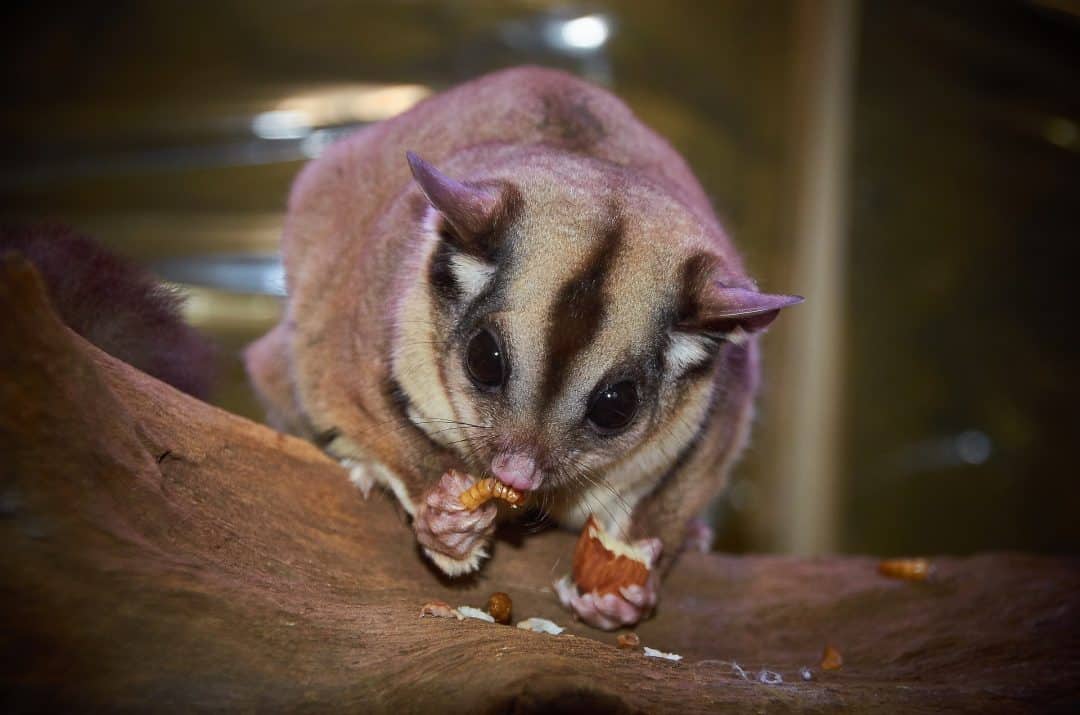

Sugar glider forage for food in the forest. Their eyes open for the first time around 80 days after birth, and joeys will leave the nest approximately 110 days after birth. Joeys are completely contained in the pouch for 60 days after birth in order for their mothers to provide them with the necessary nourishment during the remainder of their development.

The mother has a scent gland in her pouch to attract the sightless joeys from the uterus. They are born very undeveloped and furless, with only the sense of smell being developed. The gestation period is 15 to 17 days, after which the joey will crawl into a mother's pouch for further development. In the wild, sugar gliders breed once or twice a year depending on the climate and habitat conditions. Males reach maturity at 4 to 12 months of age, while females require from 8 to 12 months. The age of sexual maturity in sugar gliders varies slightly between the males and females. As nocturnal animals, they are active at night and sleep during the day. Sugar gliders sleep huddled together to keep warm when temperatures are cool. In addition to forests, they’ve also been found in plantations and rural gardens. They sleep in canopies with large numbers of stems and nest in tree hollows with up to 10 other gliders. Sugar gliders are native to tropical and cool-temperate forests in Australia, Indonesia, and Papua New Guinea. The lifespan of a glider in the wild is approximately 3-9 years. Gliding is an effective way for these small animals to hunt food and ward off predators. This gland extends from their forelegs to their hind legs on both sides of their body, allowing them to glide upwards of 150 feet in the wild. The sugar glider has a unique gliding membrane, scientifically known as the patagium. Females also have a paracloacal scent gland and a scent gland in the pouch.


Males have a scent gland on their forehead and chest, as well as two paracloacal scent glands used for marking territory. Male sugar gliders are larger than females and have four scent glands, while females only have 2. Sugar gliders are covered with soft grey fur and white underbellies, with black stripes on their heads. Their eyes are set far apart to allow them to determine where to land when gliding. As nocturnal animals, they see well in the dark with their big black eyes. Sugar gliders are often compared to flying squirrels, however, they are more closely related to other marsupials. The origin of its name comes from their love for sugary foods such as sap and nectar and their ability to glide. The Savanna Glider lives in the tropical woodlands of northern Australia, where is range has contracted by 33% since the early 1990’s.The sugar glider is a nocturnal gliding possum belonging to the marsupial class. This reclassification means that the distribution of the Sugar Glider is substantially reduced, being limited to coastal regions in South-eastern Australia. The distinction of these three species has resulted in a substantially smaller distributions for the Sugar Glider and Savanna Glider. When considered as one species, sugar gliders were widespread, abundant and officially classified as “least concern”. Previously classified as a single widespread species ( Petaurus breviceps), recent research has revealed that the Sugar Glider is actually three genetically distinct species: Petaurus breviceps and two newly identified species, Krefft’s glider ( Petaurus notatus ) and the Savanna Glider ( Petaurus ariel ). Females can produce two litters in a year. They then leave the nest to forage for food, usually with their mother. Sugar Gliders commonly give birth to twins, which remain in the pouch for just over two months. The Sugar Glider is also one of the largest marsupials that have been confirmed to enter torpor, a state similar to hibernation, in which an animal slows its breathing and dramatically reduces its physical activity for days or even weeks, dropping its body temperature and oxygen consumption and wrapping its body into a ball. Their insatiable appetite for all things sweet, Sugar Gliders are likely important pollinators of many Banksia species. Sugar Gliders consume a wide variety of foods in their diet, feeding on nectar, pollen, seeds, insects and even on small birds and their eggs – mainly foraging in the lower layers of the forest canopy. This arrangement allows one adult to keep the young warm in the hollow while the other parent is out foraging for food. Both males and females engage in parental care. They are very social animals and live in family groups, with multiple adults accompanied by the young from that season. The Sugar Glider active at night, sleeping by day in nests made of leaves in tree hollows.


 0 kommentar(er)
0 kommentar(er)
